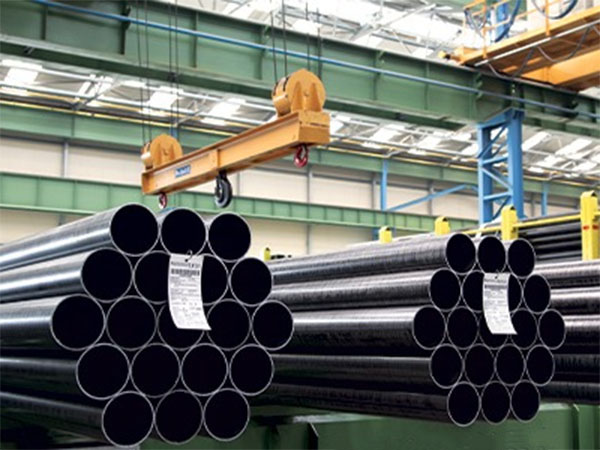Carbon Steel Welded Pipe is a type of pipe made from carbon steel materials through welding processes and is widely used in various industrial fields, such as petroleum, natural gas, chemical industry, construction, water transmission, mechanical manufacturing, etc. The following is a detailed introduction to carbon steel welded pipes:
What is carbon steel welded pipe?
Carbon steel welded pipes are made from carbon steel coils or hot-rolled plates with a carbon content typically ranging from 0.04% to 1.5%, and are processed through welding techniques to form pipes. It has various types, including ERW steel pipes, LSAW steel pipes, SSAW steel pipes and EFW steel pipes, etc.
ERW (Resistance Welded Pipe) : The weld seam of the pipe blank is heated by high-frequency current and pressure is applied to achieve fusion. There is no need to fill welding wire, and the weld seam is fine and smooth on the surface. This technology is applicable to the transportation of medium and small diameters (≤24 ") and low to medium pressure fluids.
LSAW (Longitudinal Submerged Arc Welded Pipe) : Through JCOE/UOE forming technology, it achieves longitudinal submerged arc welding on both the inner and outer sides, ensuring high straightness of the weld seam and uniform wall thickness. It is particularly suitable for large diameter (DN 600-1500 mm) and high-pressure pipes.
SSAW (Spiral Submerged Arc Welded Pipe) : It is formed by spiral rolling and then welded by submerged arc welding. It is suitable for various diameter ranges and has the advantages of high production efficiency and low cost. It is widely used in medium and low pressure water supply systems and structural supports, etc.
EFW (Electrofusion Welded Pipe) : Mainly used for special alloys or high-temperature media, with excellent weld quality.

The main manufacturing process of carbon steel welded pipes
The main manufacturing process of carbon steel welded pipes usually covers the following key steps:
1. Preparation of raw materials: The preparation of raw materials is of vital importance. High-quality steel plates or steel strips should be carefully selected as the starting materials. These materials have undergone strict inspections to ensure that their chemical composition, mechanical properties and surface quality all comply with relevant standards.
2. Forming stage: According to different types of welded pipes, such as ERW, LSAW, SSAW or EFW, corresponding forming technologies are adopted. For example, ERW steel pipes are formed by high-frequency induction heating and roller pressing. The LSAW steel pipe achieves the bending and expansion of the pipe blank through the JCOE/UOE process. SSAW steel pipes are gradually rolled into shape by a spiral plate rolling machine. However, EFW steel pipes may adopt special forming techniques to meet their application requirements.
3. Welding: ERW steel pipes are made by high-frequency resistance welding technology, while LSAW and SSAW steel pipes are produced by submerged arc welding process. As for EFW steel pipes, it uses electrofusion welding technology. During the welding process, the welding parameters must be strictly controlled to ensure the quality of the weld seam.
4. Inspection stage: X-ray, ultrasonic and other inspection methods are used to inspect the weld seams to ensure there are no defects. At the same time, conduct a comprehensive inspection of the size, shape and surface quality of the steel pipes to ensure they meet the customer's requirements and relevant standards.
5. Post-processing: such as cutting, end face processing, anti-corrosion treatment, etc., to meet the demands of different application scenarios. At this point, high-quality carbon steel welded pipes have been fabricated and are ready for factory use.
Common standards and specifications of carbon steel welded pipes
API 5L (Applicable to long-distance oil and gas pipelines /X series X42 - X70 grades)
ASTM A53/A106/B252/B333/A500: Including various uses such as structural tubes, cryogenic service tubes, high-pressure tubes, etc.
EN, DIN and JIS standards: Applicable to structural and mechanical pipes worldwide.
Outer diameter: DN 15-2000 (1/2 "- 80"), up to 3500 mm.
Wall thickness: 3-80 mm (Sch 5-XXS).
Quality control and inspection
The strict testing process covers the following aspects:
Non-destructive testing of weld seams (including ultrasonic testing UT, radiographic testing RT, and magnetic particle testing MT);
Pressure-bearing test (water pressure test and air pressure test)
Verification of chemical composition and mechanical properties
Precise control of dimensional deviation
Final visual inspection and product certification
Summary
Carbon steel welded pipes have been widely applied in multiple industries such as petroleum, chemical engineering, construction and machinery due to their high strength, excellent economy and mature processing and manufacturing technology. The key lies in clearly defining the type of welding process, standard specifications, dimensional requirements, anti-corrosion treatment and inspection procedures to ensure its long-term safe and stable operation.
